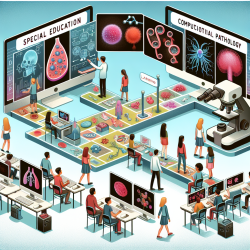The field of computational pathology (CPath) is revolutionizing the way we approach medical diagnostics and treatment, particularly in the realm of cancer care. As a Special Education Director, understanding these advancements can provide valuable insights into how we support students with special needs, especially those impacted by cancer or other medical conditions that require specialized care.
The Role of Computational Pathology in Cancer Diagnosis
Computational pathology is an interdisciplinary science that leverages computational techniques to analyze medical histopathology images. The primary goal is to develop digital diagnostics infrastructure that aids clinical pathology through computer-aided diagnosis (CAD) systems. These systems facilitate significant changes in cancer diagnosis and treatment by providing more accurate and efficient analysis of medical images.
The integration of deep learning and computer vision algorithms has led to a paradigm shift in CPath. Despite the vast amount of research and engineering efforts dedicated to cancer image analysis, there remains a gap in adopting these algorithms into clinical practice. This gap presents an opportunity for further research and development to integrate CPath tools effectively into healthcare settings.
Implications for Special Education
The advancements in CPath have significant implications for special education, particularly for students who require medical interventions. By improving the accuracy and efficiency of cancer diagnoses, CPath can potentially reduce the time students spend away from school due to medical treatments. Moreover, early and precise diagnosis can lead to better management of health conditions, allowing students to focus more on their education.
Furthermore, integrating digital diagnostics into special education programs can provide educators with better tools to understand and support the unique medical needs of their students. This integration can enhance individualized education plans (IEPs) by incorporating specific health-related goals and accommodations.
Encouraging Further Research
The current landscape of CPath offers numerous opportunities for researchers and practitioners to explore new methodologies and applications. For special education professionals interested in improving their skills and knowledge, engaging with ongoing research in CPath is crucial. Attending conferences, participating in webinars, and reading publications on the latest developments can provide valuable insights into how these technologies can be applied in educational settings.
Moreover, collaboration between educators and healthcare professionals can lead to innovative solutions that address both educational and medical needs. By fostering interdisciplinary partnerships, we can ensure that students receive comprehensive support that addresses all aspects of their well-being.
Conclusion
The integration of computational pathology into special education holds great promise for improving outcomes for students with special needs. By embracing digital diagnostics and AI-driven tools, educators can enhance their ability to support students' health and educational goals effectively. Continued research and collaboration will be key to realizing the full potential of these advancements.
Computational pathology: A survey review and the way forward?










